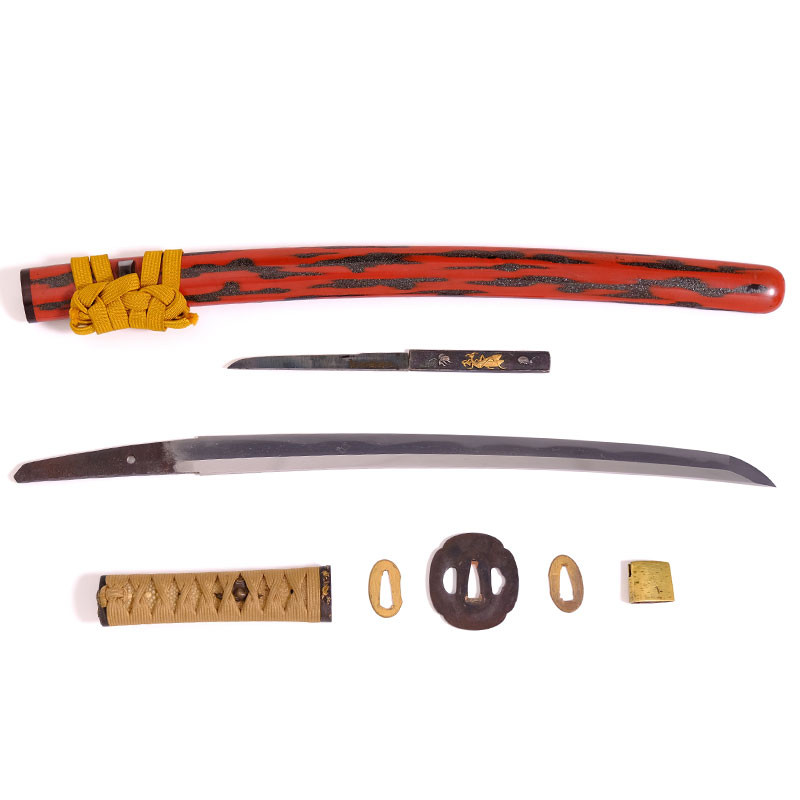













More informations about this product
| Total Weight | 0.694 kg | |
| Weight without Saya | 0.484 kg | |
| Blade Weight | 0.300 kg | |
| Full length Naked Blade (Toshin) |
50.20 cm | |
| Nagasa | 37.90 cm | |
| Nakago | 12.30 cm | |
| Sori (curvature) | 0.90 cm | |
| Kissaki Length | 3.12 cm | |
| Moto Haba | 2.67 cm | |
| Saki Haba | 1.85 cm | |
| Moto Kasane | A = 0.60 cm B = 0.66 cm |
|
| Saki Kasane | A = 0.39 cm B = 0.41 cm |
|
| Curvature | Tori Sori | |
| Type Kissaki | Elongated Chū Kissaki (typical from Yamato Den) | |
| Blade Structure | Shinogi zukuri (diamond shape) | |
| Mune | Iori mune (Triangular) | |
| Hamon | Notare in nie and nioi, Sunagashi and Uchi noke, traces of Tobi Yaki | |
| Hada | Itame | |
| Boshi | Ko-Maru Hakikake | |
| Nakago | Signed 摂津住包国 ‘Settsu Ju Kanekuni‘ on Omote side, Futsu gata (classical form), 1 Mekugi Ana, Sujikai Yasurime, Iriyamagata end (pronounced dissymmetric V) | |
| Saya | Beautiful Saya with vermilion lacquer drips on black lacquer background witha shell with pearly blue-green reflections, Sageo mustard yellow silk, rounded Kojiiri. Presence of a Kogatana with autumn insect pattern handle, typical Mino Goto school. Kogata signed 肥前國住忠吉 ‘Hizen No Kuni Tadayoshi’ in Kin Zogan Mei (gold signature). |
|
| Tsuka & Tosogu (Tsuba, Menuki, Fuchi Kashira) |
- Tsuka: :Weight 78g, size 15.2cm, Brown Silk Tsumami maki braiding, Same white, Fuchi-Kashira with turtle motifs on rocks with gilding (symbol of longevity, good luck and support), Menuki with toad motifs (symbol of success and fortune). - Tsuba:Weight 75g, size 6.4 x 5.9 x 0.35 cm, Tsuba Mokko Gata (Quadrilobed), in black patinated copper, with Kogai and Kogatana Ana, Muji surface (without pattern) in Shakudo. - Habaki:Habaki in golden copper, with horizontal Nekogaki - Seppa:2 Golden copper serrated seppa, 4g and 5g weight |
|
| Study & Team Review |
Study:
Kanekuni 包國 (6th gen), from who we present this blade, was a blacksmith of Tegai school influence 手掻 (Yamato Den 大和伝) but he formed with the great Shodai (1st generation) Yoshimichi from Osaka where he works in the Shinto Osaka style.The origin of the Tegai 手掻 school dates back to the Kamakura era (1185–1333). Tegai School is one of the 5 schools of Yamato Den 大和伝, located opposite the Tengai Mon, the western gate of Todaiji Temple in Nara. The founder of this Tegai line is Kanenaga 包永, a blacksmith of the late 13th century, whose many blacksmiths of this school inherited the 'Kane' kanji in this 包 form. The Kanekuni 包 國 lineage dates back to the 15th century, around the Eikyo era (1429-1441), and was a great success at the beginning of the Edo era, especially with the 5th, 6th and 7th generation, who had the chance to train with the best blacksmiths of Osaka of the 17th century. Kanekuni (5th gen) had the opportunity to forge for the family of Shogun Tokugawa, thanks to the invitation of his younger brother, Nanki Shigekuni 南紀重国, himself an official blacksmith of the Shogun. They worked in collaboration with the great Echizen Yasutsugu 越前康継. Kanekuni (6th gen) was invited, around 1675, to leave the province of Yamato (Nara) to train with the Shodai (1st gen) Osaka Tamba No Kami Yoshimichi, with whom he learned the famous hamon Toranba with many Nie and Sunagashi. Kanekuni (7th gen), of its civil name ‘Tsutsui Terakuni’, was born in 1666. He was largely influenced by the Osaka Shinto forge style of his father, Kanekuni 6th gen. He was also inspired by the work of the famous Sukehiro 助廣 of the Osaka Shinto Tsuda School, creator of the Toran-Ba hamon in an O Gunome Midare style, with Ara Nie and numerous Sunagashi on the Ashi. This set is a very beautiful set, with beautiful pieces and symbolic. The blade and history of Kanekuni really reflects the atmosphere of the early Edo era forge universe, with names of the greatest blacksmiths of that period! |
|
Share your opinion
error Your review appreciation cannot be sent
feedback Report comment
check_circle Report sent
error Your report cannot be sent